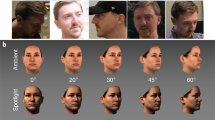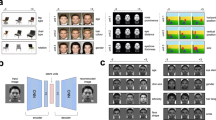Abstract
This paper analyzes properties of a certain class of approximation techniques — HyperBF networks — in face perception tasks. The problem of gender classification and identification is addressed using a geometrical description of faces, extracted automatically from digitized pictures of frontal views of people without facial hair. The HyperBF networks perform satisfactorily on the classification tasks and exhibit the phenomenon of caricaturing, previously reported in psychophysical experiments.
Similar content being viewed by others
References
Baron RJ (1981) Mechanisms of human facial recognition. Int J Man Machine Stud 15:137–178
Benson PJ, Perret DI (1991) Perception and recognition of photographic quality facial caricatures: implications for the recognition of natural image. Cogn Phychol
Bichsel M (1991) Strategies of robust object recognition for the identification of human faces. PhD thesis, Eidgenossischen Technischen Hochschule, Zurich
Bourlard H, Kamp Y (1988) Auto-association by multilayer perceptrons and singular value decomposition. Biol Cyber 59(4/5):291–294
Brennan SE (1982) Caricature generator. Unpublished Thesis, MIT
Brunelli R, Poggio T (1991) Face recognition: features versus templates. Technical Report 9110-04, published to PAMI, I. R. S. T
Brunelli R, Poggio T (1992) Hyperbf networks for gender classification. In: Proc. DARPA Image Understanding Workshop. Morgan Kaufmann, San Mateo, CA, pp 311–314
Cottrell G, Fleming M (1990) Face recognition using unsupervised feature extraction. In: Proceedings of the International Neural Network Conference Kluwer Dordrecht, pp 322–335
Golomb BA, Lawrence DT, Sejnowski TJ (1991) Sexnet: A neural network identifies sex from human faces. In: Advances in neural information processing systems 3, Morgan Kaufmann, San Mateo, CA, pp 572–577
Kirby M, Sirovich L (1990) Application of the Karhunen-Loeve procedure for the characterization of human faces. IEEE Trans Pattern Anal Machine Intell 12(1):103–108
Micchelli CA (1986) Interpolation of scattered data: Distance matrices and conditionally positive definite functions. Constr Approx 2:11–22
Poggio T (1990) A theory of how the brain might work. LV of Cold Spring Harbor Symposia on Quantitative Biology. Cold Spring Harbor Laboratory Press Appl Artif Intell, pp 899–909
Poggio T, Girosi F (1989) A theory of networks for approximation and learning. A. I. Memo No. 1140, Massachusetts Institute of Technology
Poggio T, Girosi F (1990) Networks for approximation and learning. Proc IEEE 78:1481–1497
Poggio T, Stringa L (1992) A project for an intelligent system: vision and learning. Int J Quant Chem 42:727–739
Rhodes G, Brennan SE, Carey S (1987) Identification and ratings of caricatures: implications for mental representations of faces. Cogn Psychol 19:473–497
Stringa L (1991) Automatic face recognition using directional derivaives. Technical Report 9205-04, I. R. S. T
Stringa L (1991) Eyes detection for face recognition. Technical Report 9203-07, I. R. S. T
Turk M, Pentland A (1990) Eigenfaces for recognition. Technical Report 154, MIT Media Lab Vision and Modeling Group
Author information
Authors and Affiliations
Rights and permissions
About this article
Cite this article
Brunelli, R., Poggio, T. Caricatural effects in automated face perception. Biol. Cybern. 69, 235–241 (1993). https://doi.org/10.1007/BF00198964
Received:
Accepted:
Issue Date:
DOI: https://doi.org/10.1007/BF00198964




